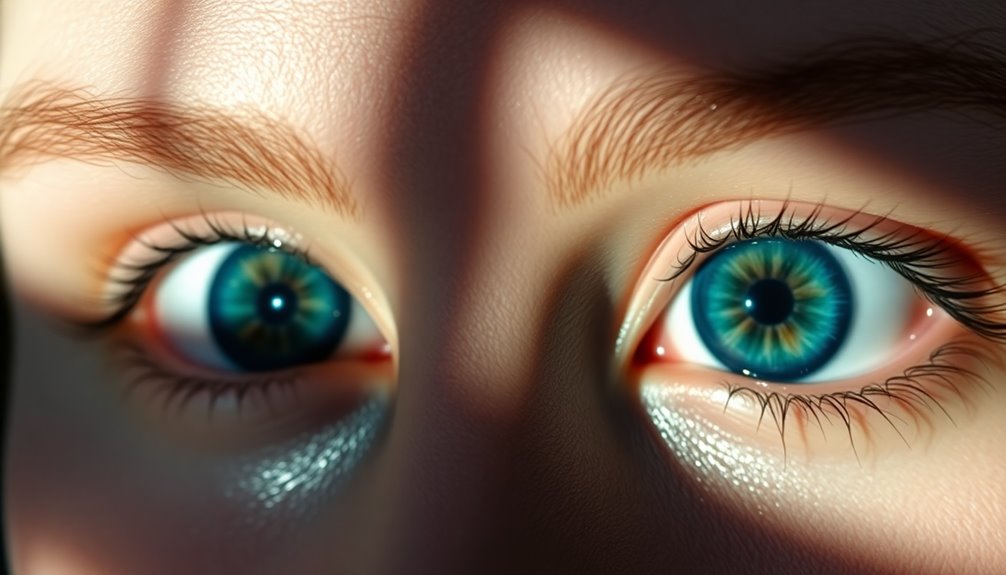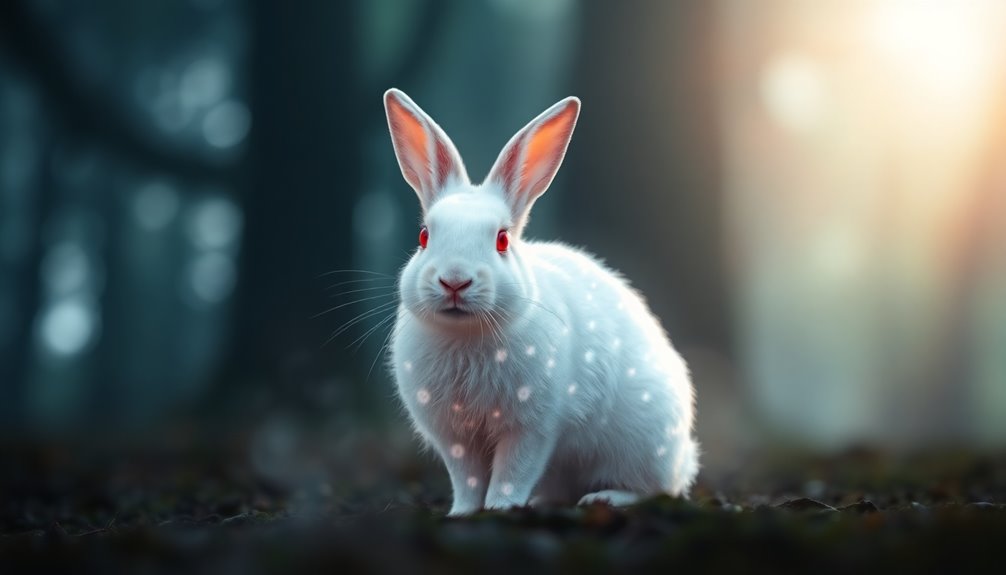Cardinals are much more than just pretty birds; they have amazing symbolism! Often seen as messengers from loved ones who've passed on, they bring hope and comfort during tough times. Their bright red color stands for energy, love, and renewal, which can cheer you up. In different cultures, like Native American and Christian beliefs, cardinals symbolize joy, emotional strength, and even new love. When you spot a cardinal, it's like a little reminder that you're not alone and that better days are ahead. If you're curious about more wonderful meanings they carry, there's plenty more to discover!
Key Takeaways
- Cardinals symbolize hope and spiritual connection, often seen as messengers from deceased loved ones during times of grief.
- Their vibrant red color represents energy, renewal, and passion, linking to themes of life and salvation.
- In various cultures, cardinals are associated with love, good fortune, and the blood of Christ, symbolizing new beginnings.
- Sightings of cardinals during significant life events are interpreted as meaningful signs, offering comfort and emotional resilience.
- Their presence in nature symbolizes joy and well-being, enhancing the uplifting soundtrack of the environment.
Spiritual Significance of Cardinals

Seeing a cardinal can evoke a sense of spiritual connection and comfort. When you spot one, it often feels like a special sign, a little message from the spirit world. Many believe that cardinals are used as messengers from loved ones who've passed on, bringing hope and joy to those who are grieving. The saying, "When cardinals appear, angels are near," captures this beautiful belief perfectly.
Cardinals are vibrant red, which symbolizes energy and renewal. This color can remind you of the blood of Christ and themes of salvation. In various Native American cultures, cardinals are seen as symbols of healthy relationships and domestic harmony. They guide you on your spiritual journey.
When you see a cardinal during a tough time, it can lift your spirits and encourage you to keep moving forward. These birds embody hope and new beginnings, making their presence especially comforting during challenging moments.
Cardinals as Messengers From Beyond

Often appearing when you least expect it, the sight of a cardinal can feel like a profound connection to the spiritual dimension. Many believe these vibrant birds bring messages from loved ones who have passed away. When cardinals appear, they often symbolize hope and comfort during tough times.
Here's a quick overview of how cardinals serve as messengers:
| Symbolism | Meaning | Connection |
|---|---|---|
| Spiritual Messages | Signs from deceased loved ones | Connection to the spirit world |
| Hope | Reminders of enduring love | Renewal in times of grief |
| Good Luck | Protection and guidance | Support from ancestors |
People often report sightings of cardinals right after losing someone special. It's as if these birds carry messages from the beyond, helping you feel connected. In Native American traditions, cardinals are viewed as good luck and spiritual guides. Their bright red color represents life and liveliness, reminding you that your loved ones are always near, cheering you on! So, the next time you see a cardinal, remember it might just be a little message of hope!
Symbolism in Relationships

Cardinals symbolize love and loyalty, embodying the strength of relationships through their monogamous nature. When you see a cardinal, it's a reminder that love can be deep and everlasting. The vibrant red color of these birds represents energy and liveliness, reminding you that maintaining passionate relationships is important.
Here are some ways cardinals enhance our understanding of relationships:
- They reflect the bond between partners, showing that commitment is key.
- Their presence can signal new love or strengthen existing connections.
- Cardinals are often seen as omens of a nurturing and harmonious home. Additionally, the symbolism of cardinals can serve as a reminder of the importance of emotional regulation in fostering healthy relationships.
When cardinals appear in your life, it's like a little message that angels are near, encouraging you to cherish your loved ones. The idea that these birds can signify the enduring connections with those who've passed away adds a beautiful layer to their symbolism. Additionally, cardinals remind us that cultivating emotional intelligence can lead to deeper connections and stronger relationships.
Cultural Beliefs About Cardinals

Cardinals are truly special birds with different meanings in various cultures!
In Native American beliefs, they act as spiritual messengers, bringing comfort and guidance.
Meanwhile, Christians see them as symbols of hope and the blood of Christ, showing just how important these bright birds are around the world!
Native American Interpretations
In many Native American cultures, cardinals serve as powerful spiritual messengers that bring guidance and comfort during times of loss or hardship. When you spot a cardinal, it can feel like a sign that good things are coming your way.
The Cherokee people, for instance, see cardinals as symbols of femininity and the sun, representing hope and restoration.
Here are a few key interpretations of cardinals in Native American beliefs:
- Healthy Relationships: Cardinals are seen as omens of strong family bonds and domestic harmony.
- Good Fortune: Many tribes believe that seeing a cardinal indicates positive changes on the horizon.
- Vitality and Renewal: The vibrant red color of cardinals is linked to life force, reinforcing their role as symbols of renewal and strength.
When you think about these meanings, it's easy to see why cardinals hold such a special place in Native American cultures.
They remind you that even in tough times, there's always hope for new beginnings and brighter days ahead!
Christian Symbolism and Meaning
Throughout Christian traditions, the cardinal is often embraced as a potent symbol of life and hope. These beautiful birds, especially their vibrant red feathers, remind us of Christ's sacrifice. The red color represents the blood of Christ and the promise of salvation. When you see a cardinal, you might think of the meaning of cardinals in the context of faith and renewal.
Many Christians believe that these birds carry a special message of hope, especially during tough times. When you spot a cardinal, it can feel like a comforting presence, reminding you that loved ones who've passed away are still close, watching over you. This belief reinforces the idea that love never truly fades.
In the Christian context, cardinals symbolize resurrection and eternal life. Their lively nature reflects the joy of spiritual life and the hope that comes with it.
Cultural Variations of Significance
Bird watchers and nature enthusiasts often marvel at the cardinal's striking red plumage, which carries a wealth of cultural significance across different traditions. The cardinal is a symbol of hope and joy, appearing in many cultures with unique meanings.
Here are some fascinating beliefs about cardinals:
- In Christianity, red cardinals symbolize the blood of Christ, representing life and resurrection.
- Native Americans see cardinals as spiritual messengers that provide comfort, guidance, and good fortune.
- In Japan, these birds are symbols of happiness and marital devotion, fostering harmonious relationships.
When you spot a cardinal, it's not just a pretty bird! Red cardinals represent life and are often seen as good luck charms. Many people believe that when cardinals appear, they carry messages from loved ones who've passed away.
These beautiful creatures remind us of love and connection, making their presence feel special.
With their vibrant color and rich symbolism, cardinals truly brighten our lives. So next time you see a cardinal, take a moment to appreciate the joy and meaning they bring!
Personal Encounters With Cardinals

Many people share profound personal encounters with cardinals, often interpreting these moments as meaningful signs from loved ones who've passed away.
Imagine sitting quietly, thinking about someone you miss, and suddenly, a bright red cardinal appears nearby. It can feel like a comforting hug from the spirit of that loved one, reminding you they're still with you in some way.
These experiences can happen during times of grief or reflection, making cardinals seem extra special. You might notice them during significant life events or when you're feeling down. When a cardinal lands close by or behaves in a unique way, it often feels like a sign, a little nudge that everything's okay.
People often report increased sightings of cardinals right after losing a family member. This makes them believe these birds are spiritual messengers, bringing peace and reassurance.
It's as if the cardinals are saying, "Your loved one is safe and watching over you."
Attracting Cardinals to Your Garden

If you want to attract cardinals to your garden, it's all about their favorite foods and cozy homes!
Start by adding platform feeders filled with dark berries and sunflower seeds, and don't forget to set up fresh water in open basins.
Planting native shrubs and trees like pine or spruce will help create a safe space for them to nest and play, making your garden a cardinal paradise!
Ideal Feeding Practices
To successfully attract cardinals to your garden, set up platform or tray feeders filled with their favorite foods, like dark berries and sunflower seeds. These treats not only help you see a cardinal but also nurture them.
Remember, cardinals have a special meaning in many cultures, symbolizing joy and hope. By following ideal feeding practices, you can serve the living God by caring for these beautiful creatures.
Here are some tips to create a welcoming space for cardinals:
- Fresh Water: Provide open basins filled with clean water. Cardinals love to drink and bathe, especially when natural sources are frozen.
- Clean Feeding Area: Keep your feeders free from moldy seeds and debris. This guarantees the health of the cardinals and encourages their return.
- Natural Shelter: Reduce pruning in your garden. Thickets give cardinals a safe place to hide and forage for food.
Native Plant Recommendations
Attracting cardinals to your garden starts with choosing the right native plants that provide both food and shelter. By incorporating these plants, you can create a welcoming environment for these beautiful birds.
| Plant Type | Purpose | Example Plants |
|---|---|---|
| Native Shrubs | Food and shelter | Serviceberry, Dogwood |
| Berry-Producing Plants | Natural food source | Holly, Sumac |
| Cardinal-Friendly Trees | Nesting sites | Pine, Spruce, Shrub Roses |
| Feeding Stations | Enhance visits | Platform feeders with dark berries |
Adding dense native shrubs like serviceberry and dogwood gives cardinals a cozy spot to hide and feed. Berry-producing plants such as holly and sumac offer tasty treats for them. Plus, trees like pine and spruce provide excellent nesting sites, keeping them safe from predators.
Don't forget to keep your feeding area clean! Using platform or tray feeders stocked with sunflower seeds can increase cardinal visits. Finally, by minimizing pruning and allowing natural thickets to grow, you create a perfect habitat for cardinals. With these simple steps, you'll soon enjoy the cheerful presence of cardinals in your garden!
Cardinals and Grief Support

Many people find comfort in the presence of cardinals during times of grief, as these vibrant birds often serve as powerful symbols of connection to lost loved ones. When you see a cardinal, it can feel like a special message from the spirit world. Many believe that these beautiful birds help with cardinals and grief support, reminding us that our loved ones are still nearby.
Here are a few reasons why cardinals can bring you comfort:
- Messengers from the spirit: Spotting a cardinal can feel like a hug from a loved one who's passed.
- Symbol of good luck: Seeing a cardinal can bring hope and positivity, lifting your spirits.
- Warmth and nostalgia: Their bright red color evokes happy memories, helping you heal.
Engaging with nature, especially by observing cardinals, can be a great way to cope with emotional pain. Their presence offers solace, reminding you that love continues even after loss.
Cardinal Symbolism in Nature

Cardinals, with their striking red feathers and melodious songs, play a significant role in the natural world, embodying themes of passion, energy, and hope. Their vibrant red stands out beautifully against green trees and blue skies. This bright color symbolizes liveliness and draws your attention, making cardinals a joyful sight in gardens and backyards.
When you hear their sweet songs, it adds a lovely touch to nature's soundtrack, bringing happiness to your day. Cardinals are year-round friends, showing incredible loyalty to their territory. Their presence reminds us of resilience, as they thrive in various environments, even during tough seasons.
These birds aren't just pretty; they also lift your emotional well-being. Spotting a cardinal can make you feel connected to nature, sparking feelings of joy and comfort.
In many cultures, cardinals are regarded as symbols of hope and connection, teaching us the importance of staying close to loved ones.
Other Birds as Good Omens

When you think about birds, many of them bring joyful messages and good vibes!
Doves remind us of peace and new beginnings, while eagles inspire strength and courage.
Hummingbirds, with their vibrant energy, show us that joy can be found in life's little moments.
Birds Symbolizing Peace
Throughout various cultures, birds have long been seen as symbols of peace and good omens, each carrying unique messages of hope and transformation. When you think of birds like the cardinal, you might picture a vibrant red bird flitting through the trees. The cardinal means new beginnings and reminds us that change can be beautiful.
Other birds also share this uplifting symbolism, including:
- Doves: Universally recognized as symbols of peace, they embody love and harmony.
- Hummingbirds: These tiny marvels bring joy and positive energy, reminding us of life's sweetness.
- Blue Jays: Fearless and intelligent, they signify good omens during times of change.
These birds help us see that nature communicates in delightful ways. Each one carries a message that encourages us to embrace transformation and seek peace. Additionally, just like the nurturing role of caregivers, these birds symbolize the emotional support that fosters resilience and hope in our lives.
Whether it's the gentle coo of a dove or the cheerful song of a cardinal, these feathered friends inspire us to find joy and hope in our lives. So, the next time you spot a bird, remember the beautiful meanings they hold!
Eagles and Strength
Eagles soar above the landscape, embodying strength and resilience with their majestic presence. These incredible birds are symbols of empowerment and independence. When you see an eagle, it's like a reminder to rise above your challenges.
Eagles have sharp vision and can fly high, inspiring you to look at life from a new perspective.
In many Native American cultures, eagles are sacred messengers, connecting the physical and spiritual worlds. This means they carry wisdom and protection, encouraging you to trust yourself. When an eagle crosses your path, it can signify a time of transformation, urging you to embrace your true potential.
Eagles are also leaders in the animal kingdom. They show you the importance of taking charge of your life and pursuing your dreams with determination. Just like eagles, you can be strong and independent, finding your own way in the world.
Hummingbirds Bring Joy
Birds often carry powerful messages, and hummingbirds are no exception. These tiny, vibrant creatures symbolize joy and positivity. Their energetic flights and beautiful colors can brighten your day, reminding you to embrace happiness. When you see a hummingbird, it's a sign to appreciate life's little wonders. Aromatherapy can also promote relaxation and enhance your overall sense of well-being, much like the uplifting sight of hummingbirds in your garden.
Consider these delightful aspects of hummingbirds:
- They hover and dart in all directions, showing us the importance of adaptability.
- Their presence often signals good luck and positive changes coming your way.
- Watching them can fill your heart with excitement and playfulness.
- Just like the calming ritual of brewing Earl Grey tea, observing hummingbirds can enhance your mindfulness and appreciation for the moment.
When you spot a hummingbird in your garden, take a moment to feel the joy they bring. They encourage you to pause and reflect on what you're grateful for.
It's a reminder to appreciate the small things, like a sunny day or a blooming flower. Hummingbirds inspire you to cherish the present moment and stay open to life's surprises.
Importance of Habitat Preservation

Preserving natural habitats plays an essential role in sustaining cardinal populations, as these vibrant birds rely on dense shrubs and trees for nesting and shelter. You mightn't realize how important it's to protect these areas.
When you plant native plants in your yard, you create a welcoming space for cardinals and other wildlife. These plants provide food and homes, helping to support their survival.
By reducing pesticide use, you can make your garden a healthier place. This means fewer harmful chemicals for cardinals and other birds. Healthy ecosystems thrive when we prioritize habitat preservation.
Join in on conservation efforts that protect wetlands, forests, and gardens. Every small action counts!
Educational programs can help you learn more about why maintaining natural environments is vital for cardinals and their friends.
When you work together with your community, you can make a difference. By taking care of the places where cardinals and other creatures live, you're not just helping the birds; you're also ensuring a vibrant ecosystem for future generations.
Let's celebrate the beauty of cardinals by protecting their homes!
Frequently Asked Questions
What Does It Mean When God Sends a Cardinal?
When you see a cardinal, it might feel like a special sign from God.
Many believe it's a message of love and comfort, especially during tough times. This bright bird can remind you that you're not alone and that hope is nearby.
It encourages you to pay attention to your feelings and surroundings. So, keep your heart open! That cardinal could be guiding you toward joy and new beginnings.
When a Cardinal Is Near an Angel Appears?
When you see a cardinal, it can feel like a special moment, almost magical! Many believe that cardinals are signs that angels are nearby, bringing comfort and love.
You might notice them during tough times or when you're thinking about someone you miss. Their bright red color brightens the day and lifts your spirits.
Is It Good Luck to See a Cardinal?
You might feel a spark of joy when you see a cardinal! Many people believe it's a sign of good luck.
The bright red color can make you think of energy and new beginnings. Some cultures even see cardinals as messengers from the spirit world.
What Is the Message of the Red Cardinal?
When you spot a red cardinal, it's like a little burst of joy!
This beautiful bird often carries messages of hope and comfort. Many believe that seeing a cardinal means a loved one who's passed is watching over you.
It reminds you to cherish your relationships and embrace love.
Conclusion
So, when you see a cardinal, think of it as a little messenger, bringing joy and reminders from the spirit world. They symbolize love, hope, and the connection we share with those we've lost. Just like a bright red coat on a chilly day, they can warm your heart and lift your spirits. Remember, each sighting might hold a special meaning just for you. So, keep your eyes open and let the cardinals inspire you!











